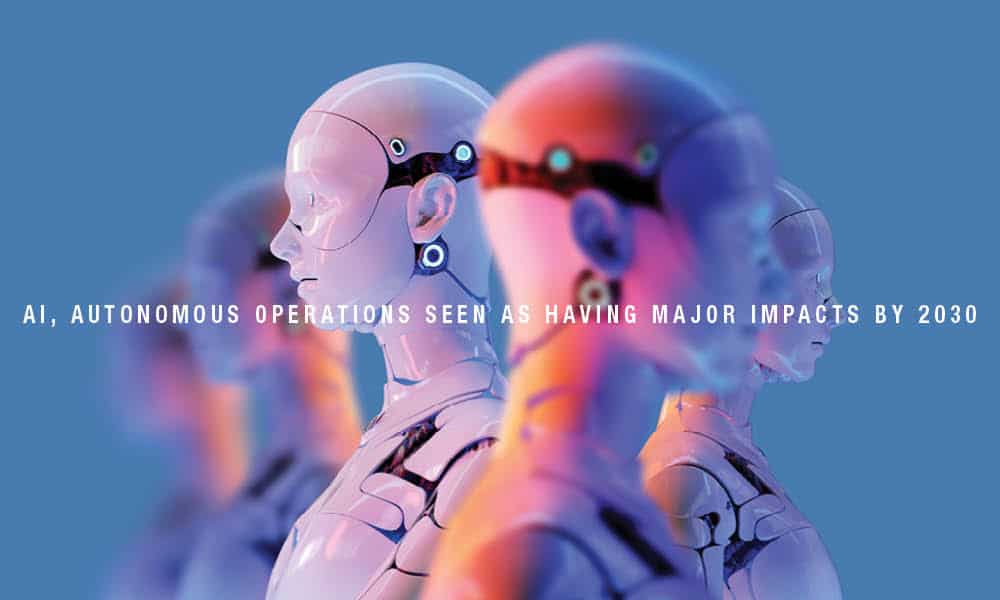AI, Autonomous Operations Seen as Having Major Impacts by 2030

In a roundtable discussion, MLC Board members also opine on the evolution of supply chains, sustainability, and leadership requirements in the years ahead.

TAKEAWAYS:
● Artificial intelligence technology will have a substantial impact on operations and supply chains well before 2030.
● Autonomous factory and plant operations will happen but it will not make sense for every type of operation.
● Leaders will need to be able to manage the interface between the AI world and human world.
In October, six members of the Manufacturing Leadership Council’s Board of Governors gathered virtually to talk about what manufacturing might look like in 2030. The Board members discussed the potential impact of AI, autonomous operations, how supply chains may be architected, what status sustainability will have by the next decade, and the leadership behaviors and skills executives will need to lead digital businesses. The following are excerpts from that roundtable.
Q: How significant do you think AI is going to be in manufacturing operations by 2030?
Dan Dwight: I think AI is going to be core for us by 2025. I’m thinking of AI in the more traditional sense, making algorithms self-correcting to the point where you no longer have your operators having to do anything on the line. It’s going to empower the people.

Ron Castro: I think Dan is absolutely right that by 2025 we’ll see a lot of this. We’re already seeing quite a bit of an acceleration after ChatGPT and now the focus on AI for business. AI for the enterprise is accelerating as well. AI will be at the core of the any end-to-end supply chain, any end-to-end manufacturing process. But I also think there will be drastic changes on the human machine collaboration. How we interact with machines that are enabled by AI will be much more intuitive than it is today.
What’s coming as well is how we mentor the capabilities of more junior members of our teams. With AI, you’re able to capture a lot of knowledge, experience, and know-how from people who will be leaving the industry in the next few years. I think we’re starting to see it already in the last couple of years, but it just doesn’t seem to be a trend that’s going to slow down given the demographics.
There will have to be significant governance as we go forward. As we go into the future unstructured data will become much more critical as well. Having the capability to absorb and be able to optimize and understand what unstructured data is telling us will be key.
Rebecca Teeters: I hope to use it to really augment the great talent that I already have. And it’s interesting, sometimes humans are a little bit too close to a problem that we don’t think about it rationally. Sometimes we have assumptions, and we do all kinds of interesting calculations almost subconsciously that might lead us down the wrong path, where AI might not do that.
It’s actually a good checking mechanism on our scientific rigor in some of the decisions we’re making. So I see it as a technology that can augment the power of our people versus a replacement technology.
The key will be how we’re able to prioritize and focus on a few key opportunities and not try to apply these technologies to everything at one time, because then we’ll just overwhelm our ability to manage the change.
Q: Does anyone see a pushback coming from the workforce on AI or overreach by government to try to govern the technology?

Dan Dwight: At least to date, with Cooley becoming more data oriented and now having more sophisticated operator screens available to the folks on the line, our workforce has been gobbling it up. They love it because in some ways it makes their job easier. They’re no longer guessing, and when they’re guessing in my world, it’s going to result in a mistake. We don’t want to make a bad product, so the fact is we can optimize the facility, make their life easier and create better products.
But workers are still playing a role looking at that operator board, still making manual adjustments because we’re not yet there on complete AI. When we do get there, a person’s role is going to be very different. We’re still not sure exactly what that might look like for them.
Jim Davis: I do not see pushback from the existing workforce. There is generally high interest in engaging, as Dan says. I will add, though, that workers need to be aware, see leadership interest, and have access to the capabilities. We still see the gap widening between the larger companies that have the resources and those that don’t, and we still don’t see that manufacturing is viewed as a particularly high-tech profession from a future workforce standpoint. I did want to mention there can be workforce concerns with privacy and personal intrusion if AI is used to monitor individuals. I really like this new term of “co-piloting” that has emerged. It better communicates the value of using AI to support the worker to do his or her job better.
Q: Do you expect a loss of jobs in in the industry as a result of widespread AI adoption?
Dan Dwight: I don’t.
Jai Sundararaman: This is like a watershed moment. For the last seven decades, we were just talking about lean, nothing else. So now it’s AI. It’s going to be the AI generation for the foreseeable future. We can just say from our own experience, we thought we were operating best-in-class, but we raised our bar significantly beyond what we thought was possible with AI now.
In the future, factories without AI will struggle to attract top talent. Candidates will demand, ‘Do you have AI?’ If the answer is no, they’ll simply walk away.
Ron Castro: My view is the cost of entry of leveraging AI has been going down and will most likely continue to go down. This will make it less prohibitive for smaller and medium sized companies to start to play in in AI. By 2030 the cost of entry will be much lower than it is today, enabling smaller and medium sized companies to really play in this space as well.
Q: What other technologies will have a significant impact on manufacturing by 2030?
Ron Castro: A key point is the exponential value of having technologies interact with each other. For example, with 5G and IoT talking to each other and the more data they generate, the more insights we can get out of the data. So I think the aggregate of technologies will continue to grow.
And quantum. What quantum computers do extremely well is very complex optimization exercises. I really think by 2030 we will see some breakthroughs in quantum computing. Imagine AI interacting with quantum, simulating millions of possible scenarios which cannot be done by conventional computers and AI picking up on that ‘training’ data generating real time insights which we can only dream of today.
Jai Sundararaman: 3D printing continues to be an exciting frontier, with evolving technologies unlocking a multitude of possibilities. The integration of technology traceability and sustainability through digital twin concepts holds immense promise, poised to reshape the landscape in a truly transformative way.
John D. Gagel: I’ll just chime in on what Jay said. It’s that whole concept of a digital passport. So imagine having all the information about where your product came from, where it was manufactured, down multiple layers in the supply chain — a digital passport at your fingertips.

Rebecca Teeters: Well, in in my world, in the chemical world, the digital twin concept is just huge. The ability to model chemical reactions under certain situations to understand how, for example, a reactor system going to behave. That’s a big focus point for us because it saves us a lot of time and a lot of energy if we can do some digital twinning and understanding where things are working and where things aren’t working.
Other key technologies include being able to supplement human talent with digital goggles and additive manufacturing is just really taking hold.
Q: How do you see the architecting of supply chains playing out by 2030?
Ron Castro: Designing supply chains for resiliency versus just for cost will have more weight, although I suspect at some point cost will continue to be a key factor. But we will need to have the right tools in place to manage that resiliency. The continued expansion of digitally-enabled supply chains will continue to grow, in my view, exponentially. We’re just on the tip of the iceberg here with generative AI — and that’s going to continue to accelerate. In the future there will not be a process or a task or a supply chain operation that will not be augmented in some way by AI. This will create a faster evolution that will force companies to really rethink their processes.
Rebecca Teeters: My view is a very simple. Operational excellence. Architecting supply chains to get them as close to the point of consumption as possible. One, they’re more resilient that way, but two, just less inventory in the system, right? You have less material in the system at any given time that allows you to just flow material faster and you gain significant productivity. It’s fundamental cycle time math.
And honestly, we’re also seeing the fact that the world is flattening. There’s less variation in labor costs and utility costs and all these variables that have historically encouraged us to offshore and kind of move things around and chase all of these variables. I think the time has come to stop chasing the sweet spot and really design and architect supply chains for optimum flow. Not only material flow, but financial flow. That will gain us huge productivity advantages from my perspective.
Dan Dwight: But what I think is really interesting is, if you look at manufacturing to date, at least from the Cooley perspective, it’s been very internal focused within the walls of our factory — how we are digitizing, how we are driving AI, how we are becoming more resilient within the manufacturing process. We now have to go external and bring that resiliency model to our external partners, which will require us to open up and be even more transparent with our vendors and our customers. That is a lot more challenging.

Jim Davis: Ten years ago the manufacturing focus was largely about what happens within “my” company. No one was seriously thinking about supply chains as factories and end-to-end supply chains interoperating. If you fast forward to today, this industry and factory view has come into play with industry (and government) emphasizing importance. The implementation and needed scaling have not been worked out, however. Data are needed in factories, but also throughout supply chains for operational interoperability and for the materials and products visibility that addresses supply chain resilience. Data are also needed to address a significant increase in complexity. Demand dynamics, product customization, tighter specifications, faster setups, etc., have all increased while at the same time, economic, environmental, and social sustainability requirements are increasing, converging, and impacting factories and supply chains. You have to manage this complexity with increasing automation and autonomy that underpin simpler interfaces for higher level decision making.
Q: How close do you think the industry will come to autonomous factory operations by 2030?
Rebecca Teeters: I think there will be scenarios where we get there by 2030, for sure, and scenarios where we don’t, and part of that will just be the sheer capacity to change that much over the course of the next six years or so. For example, we are installing currently state of the art water treatment facilities at our chemical factories around the world. And as I look at these facilities, they’re very complex but I think these can be autonomous operations.
I should be able to operate these water treatment facilities lights out 100% autonomous and I should be able to do that in the next five or six years.
I think it’s going to depend on us making some very clear prioritization decisions and driving a few of them to the end point. This is absolutely possible and necessary in my opinion.
Dan Dwight: So having our extruders run autonomously through algorithms and AI, but it’s not complete lights out because you’re still going to have material handling issues. So I guess it’s how far down the spectrum you’re going toward ultimately being fully lights out?

Jai Sundararaman: In Taiwan, some companies in our industry have already embraced lights-out manufacturing for the past decade. With labor costs on the rise and a scarcity of available workers, it’s becoming increasingly clear that by 2030, many plants will be on the verge of lights-out operations. As we strive for cost-effectiveness, our industry is maturing in automation and digital process adoption, suggesting that we may soon achieve near lights-out capabilities.
John D. Gagel: I think it will depend on the process or the industry that you’re talking about. How far down the path they can go with lights out? Some of your more chemically intensive processes due to regulatory pressure may not. I don’t think you’ll see them go very far just because there’s a whole host of regulatory oversight requirements for heavy chemical processing or what you would consider high risk.
Ron Castro: It might not be lights out, but as I mentioned before, every single task will be enabled with technology, most likely AI. We’ll clearly be more intelligent and more optimized, either directly by AI or by humans being assisted by AI. By now we transformed approximately 80% of our internal processes to either be automated through AI or our supply chain professionals being augmented by AI. There is still a lot of work ahead of us in cross-company processes across the value chain. We as supply chain leaders need to push further digitization and automation across the value chain with our suppliers and our partners.
Jim Davis: There will be some situations where lights out will make sense. However, I see this more as automation and autonomy needing to increase to address the economics of competitiveness, increasing requirements, increasing complexity, and using the workforce in better ways (AI is critical). There’s a lot of economic headroom to drive a progression of human involvement, control, automation, and autonomy, but it is expensive. When we talk across companies and industries, economics remains the key driver. Importantly, there is a process in building the maturity that comes from using data and gaining a deeper understanding of the operation so automation and autonomy can be implemented and sustained with trust. This mindset about data and a maturity process with staged benefit and investment is not accounted for very well yet.
Q: How do you see the industry’s current focus on sustainability playing out by 2030?

John D. Gagel: I think I’ll go back to something that Ron said. This is a material science issue in my opinion. Sustainability is well established in the market. We all know the increasing regulatory requirements for reporting. So there is going to be a need for a lot of data now coming off of manufacturing and that’s where I think all the things we talked about will help. But the material science issue is the one that that it is getting increasingly challenging. For example, one of the most recent topics is PFAS (polyfluoroalkyl substances) compounds. If you have those in your products, how do you replace them?
So as you look at what we make our products out of, you can’t use what you used to use. For example, you all those PFAS compounds. If you have those, how do you replace them?
On the product sustainability side, we’re not talking about climate impacts at the start. We’re talking about what raw materials are you using to make those products and what is the impact of that material in its entire life cycle on the planet and on people. And I think that’s where sustainability will continue to be top of mind.
Rebecca Teeters: Gone are the days when industry can say I have a right to discharge because I have a permit. The world expects industry to move towards a pollution prevention, environmental stewardship mindset, period, and it’s time that we, as industry, accept that our job is to not impact our environment while we make the specialty materials we need to make to empower the world, we need to accept that reality and we need to get after it.
We’re a little comfortable with this idea, though. Many feel we have a regulatory regime and all I have to do is be in compliance with my regulatory regime. That’s antiquated thinking. I’ve been involved in round table debates globally around environmental stewardship and the chemical industry, and this is a very tough mindset shift for the chemical industry.
Q: What skills and behaviors will manufacturing leaders need by 2030?
Rebecca Teeters: So I’ve been thinking about this recently with respect to our plant managers. First of all, we need to acknowledge the fact that the scientific first principles of manufacturing are operational excellence. You still have to know them.
Then you need to have what I call floor presence. You need to be able to actually talk to people. You need to be able to engage with people to have really good conversations and that won’t change even in the face of all this digital stuff.
We need executive presence because we need to be able to communicate well and be heard, not just speak, but fundamentally be heard in order to, I think, address the most challenging part of being a leader in the new era, which is being able to see the macro changes like the environmental stewardship view and understand how to head in that direction.
You have to be visionary and you have to be able to manage the change and bring the people with you. Leaders need to be very humble and really believe that a good idea can come from anywhere and then once they see it, knowing how to apply it with good scientific rigor and bring their people along with it.
You just have to choose wisely where you’re going to accept more risk and try new things.
Dan Dwight: I think we need digital proficiency. It is an absolute qualification for any kind of new talent, including at the leadership level, And next generation leaders need to have a collaborative nature –whether it is with the supply chain, with AI, or in extending sustainability.
Ron Castro: A global mindset, but also more of a growth mindset.
Jai Sundararaman: There are two key elements to consider. Firstly, digital literacy, as Dan highlighted, and secondly, the digital mindset. The distinction lies in understanding that leading in a digital world necessitates a different approach than simply acquiring skills.
John D. Gagel: I’ll say speed and agility. The ability to process multiple data points in in real time. And then I think the other thing is being able to manage the interface between the digital AI world and the human world. So it’s a classic leadership thing: good people skills, good communication skills. M
About the contributors:
Daniel R. Dwight is President and Chief Executive Officer at Cooley Group.
Ron Castro is Vice President and Chief Supply Chain Officer at IBM.
Dr. Jim Davis is Vice Provost IT Office of Advanced Research Computing at UCLA
John D. Gagel is Chief Sustainability Officer at Lexmark International
Jai Sundararaman is Chief Transformation Officer at Intertape Polymer Group
Dr. Rebecca Teeters is President and Senior Vice President, Chemical Operations and Fluoromaterial Stewardship at 3M